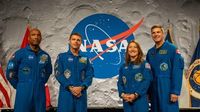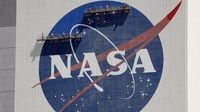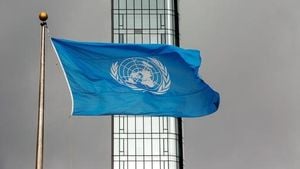Excitement is mounting at NASA as the agency edges closer to launching Artemis II, the first crewed mission to orbit the Moon in more than half a century. The mission, which marks a pivotal chapter in America’s lunar ambitions, is tentatively set to launch as early as February 5, 2026, with a final deadline no later than April of that year, according to NASA officials at a press briefing on Tuesday, September 23, 2025, as reported by ScienceAlert and Ars Technica.
Artemis II is more than just a technical milestone; it’s a moment thick with history and competitive urgency. The mission is NASA’s most ambitious human spaceflight since Apollo 17’s Moon landing in 1972, and it comes at a time when geopolitical tensions and a resurgent “space race” with China have injected new vigor—and pressure—into lunar exploration. Lakiesha Hawkins, acting deputy associate administrator of NASA’s Exploration Systems Development Mission Directorate, put it plainly: “There is a desire for us to be the first to return to the surface of the Moon. With that being said, NASA’s objective is to do so safely.”
The Artemis II crew, consisting of commander Reid Wiseman, pilot Victor Glover, and mission specialists Christina Koch (NASA) and Jeremy Hansen (Canadian Space Agency), has been in the final, intensive months of training. The four astronauts have bonded to the point of near wordless coordination. “You get to that point where you do not have to communicate any longer,” Wiseman told reporters, as quoted by Fox Weather. “I can just see the corner of an eye and know exactly what’s happening with that person.” This level of teamwork, achieved during a recent Orion spacecraft simulation, is a testament to the rigorous preparation the team has undergone over the past two and a half years.
The mission itself is a 10-day journey aboard the Orion spacecraft, aptly named ‘Integrity’ by its crew. Artemis II will be only the second launch of NASA’s Space Launch System (SLS) megarocket from Kennedy Space Center in Florida. The SLS, fully stacked on Mobile Launcher 1 since May 2025 and declared ready to fly on September 17, will propel Orion on a “free return” trajectory—an orbit that will slingshot the crew 250,000 miles from Earth, around the Moon, and back for a splashdown in the ocean.
During the mission, the astronauts will conduct biomedical research, make lunar geology observations, and deploy CubeSats from four different continents. These small satellites, as mission specialist Christina Koch explained to NewsNation, will collect data on space science, radiation, and future communication systems, providing valuable insights for universities and research institutions. “They are going to be studying things like space science, radiation, future communication systems and some of that technology development that’s so important,” Koch said.
Perhaps most tantalizing for scientists is the crew’s hope to become the first humans to lay eyes on parts of the Moon’s far side—regions that have never been directly observed by people. “Believe it or not, human eyes are one of the best scientific instruments that we have,” Koch remarked, as reported by Fox Weather. The mission plan allows the crew three full hours dedicated solely to observing the lunar surface, with the possibility of seeing newly illuminated areas depending on launch timing and lunar illumination. “We hope it’s not the dark side, we hope it’s the lit far side. Because that could mean that we could see parts of the moon that have never had human eyes lay upon them before,” Koch added.
While Artemis II will not land on the Moon—landing is reserved for Artemis III—it sets the stage for a new era of lunar exploration. The Artemis program’s long-term vision is nothing short of transformative: establishing a sustainable human presence on the Moon, learning to “live off the land” as Hawkins described, and ultimately paving the way for crewed missions to Mars. “The crew there on the surface of the moon will be trying to figure out how to live off the land,” Hawkins said during a Houston briefing, as cited by Texas local outlets. Lessons from the Apollo era are being leveraged, but the Artemis team is clear that their goals are even more ambitious.
Yet, the road to launch is anything but straightforward. The SLS and Orion are in their final stages of preparation, with NASA planning to stack the Orion atop the rocket later this year. The stage adapter, which arrived at Kennedy Space Center on August 19, 2025, will connect Orion to the SLS and shield it from flammable gases during launch. Once all components are assembled, the combined stack will roll out to the launch pad early next year, where it will be connected to ground systems. About two weeks later, a crucial “wet dress rehearsal” will take place—fully loading the rocket with propellant and running the countdown up to just before engine ignition. Only after a successful rehearsal will NASA drain the fuel and move forward to launch preparations.
However, the timeline is tight. As Ars Technica noted, the pre-launch steps for Artemis I took about eight months, and Artemis II faces added hurdles. The Trump administration’s fiscal year 2026 budget proposal threatens to cut nearly 25% of NASA’s funding—a move that could slow progress considerably. Additionally, NASA’s workforce has shrunk by 20% since January 2025 due to deferred resignations, further straining resources. Despite these challenges, Artemis II’s crew and leadership remain steadfast. “We are going to launch when this vehicle is ready, when this team is ready, and we’re going to execute this mission to the best of our abilities,” Wiseman emphasized at a recent press conference.
The larger context is impossible to ignore. The United States is not alone in its lunar ambitions. China is advancing its own program, with aims to land astronauts on the Moon by 2030. The Trump administration has openly framed the situation as a “second space race,” reminiscent of the Cold War rivalry that first sent humans to the lunar surface. “The administration has asked us to acknowledge that we are, indeed, in what is commonly called a second space race,” Hawkins said, as reported by Ars Technica. While political pressure is palpable—President Trump has pushed NASA to accelerate both lunar and Martian exploration—NASA officials repeatedly stress that safety is the overriding priority.
For the Artemis II crew, the mission is both a continuation of the Apollo legacy and a bold leap into the future. Pilot Victor Glover summed up the spirit of the team: “The race I think the most about is the relay race we are in. You know, there is a saying, if you want to go fast, go alone. If you want to go far, go together. And we are going together and our mission success is built on handing off a starting point to Artemis III that sets our country and our partners up to go back to the surface of the moon.”
As NASA moves through the final months of preparation, anticipation—and a bit of anxiety—hangs in the air. The world will be watching as Artemis II aims to take humanity farther, together, than it has gone in a generation.






